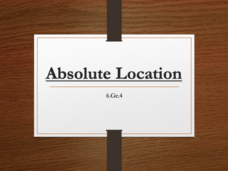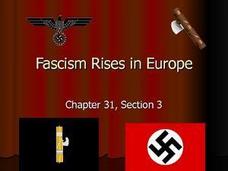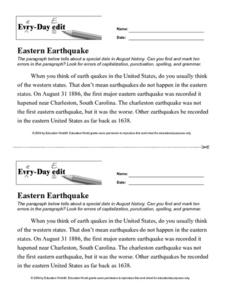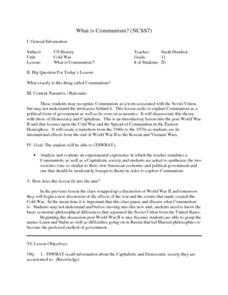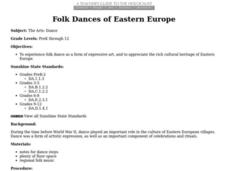Curated OER
American Foreign Policy: 1920 - 1941
Take your class through the period between World War I and World War II. Covering various treaties and pacts between America and its neighbors - namely, Japan, Germany, and the Soviet Union- these slides could inspire some political...
Mr. Head's 6th Grade Classroom
Absolute Location
How do we know where we are in the world? A presentation for middle schoolers explains absolute location and other geography terms such as relative location. It also gives scholars the opportunity to practice finding absolute location on...
Curated OER
Animals of the World: An Internet Scavenger Hunt!
Animals of the World: An Internet Scavenger Hunt!
Curated OER
Studies of the Eastern Worlds: Historical Summaries
Seventh graders interpret their own meaning of the painting, "Christ's Descent into Hell" by Hieronymus Bosch and the song "We Didn't Start the Fire" by Billy Joel. They focus on the chaos created in both the art and music and discuss...
National Endowment for the Humanities
Victory and the New Order in Europe
A New Order in Europe calls for a new lesson plan! This third plan in a series of four sequential lessons encourages high schoolers to read primary sources about the development of the New Order and follow up their knowledge with a...
University of Chicago
Exercise in Conflict Resolution
How do major religions, including Judaism, Christianity, and Islam, differ in how they view the role of individual freedoms within society, the definition of morality, and the importance of politically satisfying the greater...
Curated OER
Fascism Rises in Europe: Ch 31
Help your class understand how Hitler achieved power prior to World War II. A strong presentation outlines the post-World War I social and economic context that primed Eastern Europe for a totalitarian dictator. It presents the...
Curated OER
Ivan the Fool: Lesson 1
Students read and analyze a classic Eastern European folktale. In partners, they read the story, take notes, define vocabulary terms, and write a summary of the folktale.
Curated OER
Ivan the Fool: Lesson 3
Students read and analyze the Eastern European folktale of 'Ivan the Fool.' They discuss the term 'quest,' identify quests in their own lives, and in small groups design a board game that illustrates the czar's quest to find good wives...
Curated OER
World Map and Globe - Lesson 15 (K-3)
Students discover mountain ranges and their locations in the world. In this physical map lesson, students locate and identify major mountain ranges of the world on a large physical map.
Education World
Every Day Edit - Eastern Earthquake
In this everyday editing instructional activity, students correct grammatical mistakes in a short paragraph about earthquakes. The errors range from punctuation, capitalization, grammar, and spelling.
Council for Economic Education
The Silk Road
The Silk Road connected the European, Middle Eastern, and Asian worlds. It also helped create the modern trade world. An analysis activity makes the importance of this Chinese innovation clear by asking participants to evaluate trades...
Curated OER
Chronological Battle List
In this chronological history worksheet, students put the 15 listed World War II battles in chronological order using the provided graphic organizer.
Curated OER
Food Insecurity in a Global World: Perspectives from Africa
Students investigate food shortages. In this global issues lesson, students examine how food scarcity issues have impacted the people of Easter Africa. Students use the information they gather to determine methods of...
Curated OER
Tolerance and Genocide
Students investigate the causes of genocide. In this cultural diversity lesson, students discuss genocide incidents in Africa, the Middle East, and Eastern Europe. Students then write essays about what they would do if their cultural...
Curated OER
What is Communism?
Eleventh graders explore Communism. They explore Communism's roots in economics and discuss the spread of Communism in the Eastern Hemisphere. They evaluate a Communistic and a Capitalistic society. Students reflect upon the positives...
Curated OER
People Power
Students view a television program that explores many Eastern European residents' discontentment with communism. They work in groups to research living conditions in an Eastern European country before communism, under communism and...
Curated OER
Introduction to the Early Origins of the Cold War
In this Cold War activity, students read a 4-paragraph selection about post World War II diplomacy and then list key dates and events noted in the selection.
Curated OER
Woodrow Wilson and American Involvement in the Great War
Students examine American involvement in World War I. In this World War I instructional activity, students investigate Wilson's policy of neutrality as they read excerpts from his messages to Congress. Students respond to questions...
Curated OER
International Curiosity and National Pride
Pupils analyze their own culture and a Bulgarian culture to identify national, local, or ethnic traits. For this culture analysis lesson, students identify three important characteristics of their culture and compose a list of...
Curated OER
Night: Guided Imagery Activity
Prior to reading Night, class members engage in a guided imagery activity that helps them make text-to-self connections to Elie Wiesel’s account of his experiences with his father in Auschwitz and Buchenwald. Complete directions, as well...
Curated OER
Folk Dances of Eastern Europe
Students discover the rich cultural heritage of Eastern Europe by experiencing folk dance as a form of expressive art.
Curated OER
World Map and Globe - Lesson 15 Mountains of the World
Learners locate major world mountain ranges. In this geography lesson, students identify major mountain ranges on 6 on of the 7 continents on a large world physical map.
Curated OER
Buddhism
In this social studies worksheet, middle schoolers find the words that are related to the eastern religion of Buddhism. The answers are found at the bottom of the page.

